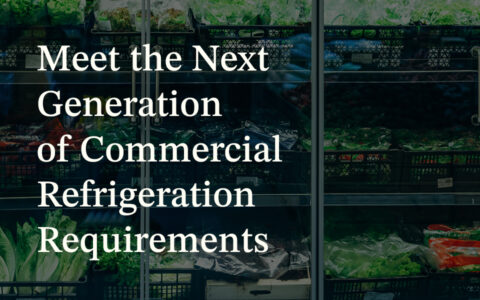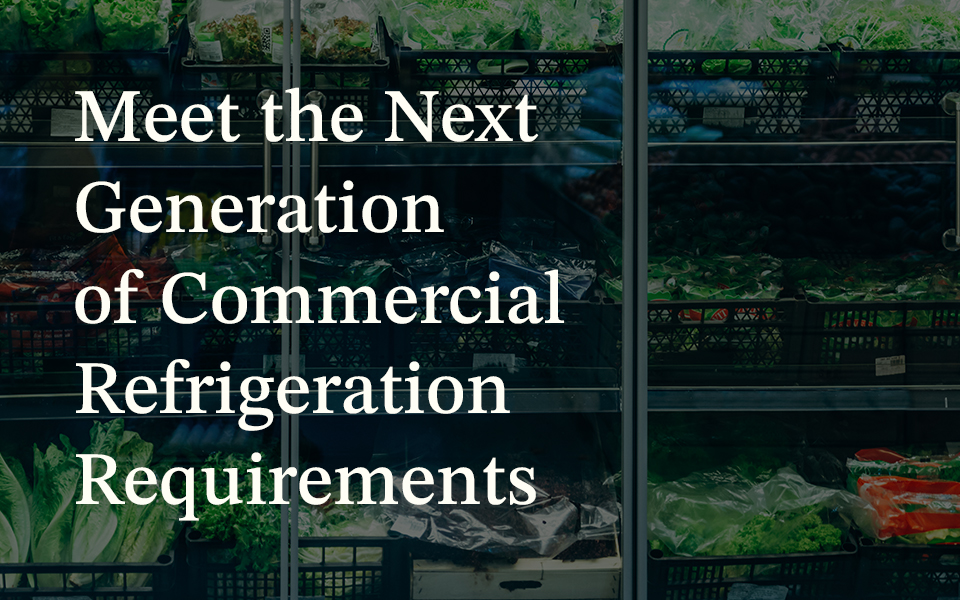Understanding the roles of CO2, A2Ls and R-290 in next-gen equipment options

*On June 1, 2023 Emerson’s Climate Technologies business became a new standalone company – Copeland. Though our name has changed, we are building on more than a century of HVACR innovation and industry leadership, and Copeland continues to offer the same products, industry stewardship, and learning opportunities you’ve grown to trust. Information found on this webpage posted before June 1, 2023 may contain our old name or branding, but you can be at ease knowing it was created with the knowledge and expertise of Copeland.
With finalized global warming potential (GWP) limits on the horizon and the hydrofluorocarbon (HFC) phasedown officially at 40 percent reductions, food retailers are entering a new phase in their refrigerant transitions. Migrating to future equipment strategies for new installations and retrofits hinges on the selection of one or more emerging lower-GWP refrigerant options. In a recent article for HVACR Business, I explored the leading equipment strategies designed to meet the next generation of commercial refrigeration requirements.

..For many supermarket, convenience store (c-store) and restaurant operators, the migration to lower-GWP equipment is a key initiative on their operational radars. Whether they’re working toward sustainability goals, reducing their dependence on HFCs, or evaluating regulatory-compliant equipment, many will face inevitable decisions within the next few years.
But with new refrigerants, equipment and system architectures rapidly emerging in the marketplace, retailers have questions about operational costs, refrigeration reliability and application safety. Many are unsure about which refrigerants will be used in which equipment types, or which types of equipment will be suitable for their future store footprints.
Per the Environmental Protection Agency’s (EPA) recent Technology Transitions final rule, GWP limits for new food retail refrigeration equipment range from 150–300 with compliance dates from 2025–2027. Lower-GWP alternatives are poised to fill distinct equipment niches — from smaller-charge, self-contained systems and condensing units to remote systems and large supermarket racks. In the changing refrigeration landscape, A3 (R-290), A2Ls (e.g., R-454A, R-454C and R-455A) and A1 CO2 (R-744) refrigerants each have their place.
R-290 in self-contained equipment
R-290 is already widely used in self-contained equipment, in which a condensing unit is integrated into the equipment. Examples include commercial ice machines, water coolers, low-temperature refrigeration and reach-in cases. To date, this equipment has all been regulated to a 150-gram R-290 charge limit.
Under the EPA’s Significant New Alternatives Policy (SNAP) 26 proposal, R-290 charge limits would be increased to 300–500 grams. If approved, this would effectively double stand-alone system capacities, supporting up to 4 horsepower (HP) compressors and potentially expanding its application to smaller walk-in units.
This increase would also simplify self-contained equipment architectures. Due to the current 150-gram charge limit, larger-capacity R-290 cases must be supported by multiple condensing units, compressors and refrigeration circuits. With increased charges, these systems could be designed to deliver more capacity with a single compressor and/or condensing unit.
A2Ls in self-contained and remote systems
A2L refrigerants have the potential to play expanded roles within a wider range of commercial refrigeration equipment — from self-contained units to remote systems. Several new A2L options have been listed as possible alternatives in the recent SNAP 26 proposal, with much higher charge limit allowances than R-290. These higher charges will enable A2Ls to be used in higher-capacity applications within the 0–60 HP range.
In self-contained equipment, A2Ls could offer refrigerant charges far above R-290’s proposed 500 gram limit, enabling larger capacities and refrigeration loads, and an improved coefficient of performance (COP).
In remote and/or distributed systems that currently use HFCs — such as outdoor condensing units that support walk-in coolers, freezers and mini racks — A2Ls would deliver much-needed, low-GWP alternatives in these applications.
It’s important to note that A2Ls cannot be used as drop-in replacements in existing HFC systems. All new refrigeration equipment and systems must be designed and qualified to use A2Ls per applicable safety standards.
CO2 in centralized rack systems
CO2 refrigeration has been a proven food retail solution for more than two decades on the global stage. Driven by sustainability initiatives and regulatory mandates, its adoption has increased significantly among North American food retailers in recent years. However, misperceptions persist about its high-pressure characteristics, system complexities and operational costs.
CO2’s many sustainability benefits, potential for heat reclaim and long-term viability all contribute to an increasingly attractive total cost of ownership (TCO) calculation. Design strategies that can optimize system efficiencies per climate zone — combined with technological advancements that simplify and automate system operation — are making CO2 booster systems an effective centralized architecture for large and small retailers alike.
Leading the way in lower-GWP refrigeration technologies
For more than a decade, Copeland has led the way in the development of lower-GWP refrigeration technologies. We’ve supported the early adoption of CO2 refrigeration and have continued this commitment with significant investments in ongoing CO2 research and development. We’ve been anticipating R-290 charge limit increases and the emergence of A2Ls for several years and have optimized compressors and condensing units specifically for these scenarios.
Today, we’re working closely with our original equipment manufacturer (OEM) partners to help develop the next generation of reliable, efficient and cost-effective refrigeration equipment — while helping retailers understand the potential TCO of their future investments. To learn more about lower-GWP refrigerants and emerging system architectures — and make more informed and confident decisions about your future equipment selections — please visit our E360 resource hub.

8 proven strategies for rigorous cold chain management
by Dan Knauer | Cold Chain
Preparing for the approval and safe use of A2Ls in commercial refrigeration applications...
Protection for high-value shipments just got even better
by Alex Axelsson | Cold Chain, Transportation
We’re excited to announce the release of Copeland’s newest real-time tracker, the GO Real-Time...

Three proven strategies to prevent cargo theft
by Chris Lafferty | Cold Chain, Transportation
The over-the-road (OTR) transport industry is experiencing a surge in cargo thefts. As thieves...
The post Understanding the Roles of CO2, A2Ls and R-290 in Next-Gen Equipment Options appeared first on Copeland.